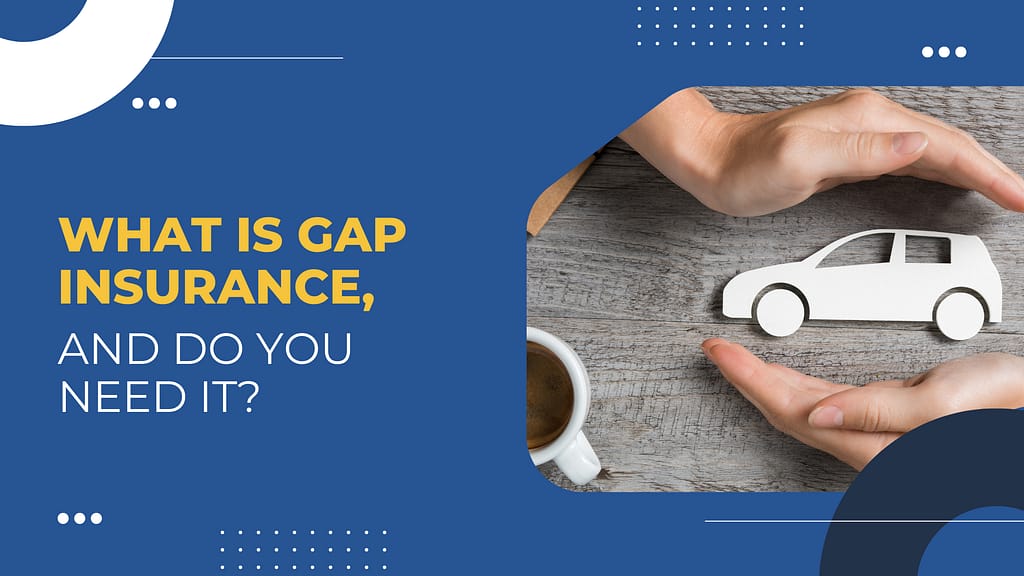Introduction
When it comes to protecting your car — and your wallet — there’s one type of insurance that often sparks curiosity: GAP insurance. If you’ve recently purchased a new or leased vehicle, you may have heard this term tossed around, but many people aren’t entirely sure what it means or why they might need it.
In this blog, we’ll discuss insurance, how it works, and whether you should consider adding it to your coverage. Let’s dive in!

What Is GAP Insurance?
GAP stands for Guaranteed Asset Protection. Simply put, GAP insurance is designed to cover the “gap” between the amount you owe on your car loan or lease and the car’s actual cash value (ACV) in the event of a total loss.
Here’s why this is important:
- Cars depreciate quickly — the moment you drive off the lot, your vehicle starts losing value. In fact, most cars lose up to 20% of their value in the first year alone.
- If your car is totaled in an accident or stolen, your standard auto insurance will typically only pay the car’s ACV, not the full amount you owe on your loan or lease.
Let’s look at an example:
Imagine you bought a car for $30,000, but after a year, its value drops to $24,000. If your car is totaled and your insurance payout is based on its ACV, you’d receive $24,000. However, if you still owe $28,000 on your loan, you’re left with a $4,000 “gap” to pay out of pocket. This is exactly where GAP insurance steps in to cover the difference.
How Does GAP Insurance Work?
It kicks in when your car is declared a total loss due to theft or severe damage. Here’s how it works:
- Your insurer pays the actual cash value (ACV): After the incident, your standard auto insurance pays the current market value of your car.
- GAP covers the remainder: This insurance pays the difference between the ACV and the remaining balance on your loan or lease.
It’s important to note that GAP insurance does not cover deductible costs, repairs, or replacement for a new vehicle. It strictly covers the financial gap between your car is worth and what you owe.
Do You Need GAP Insurance?
Not everyone needs insurance, but it can be a lifesaver in certain situations. Here are a few scenarios where GAP insurance is highly recommended:
- You’ve Financed a New or Expensive Vehicle
- New cars depreciate quickly, leaving you owing more than the car is worth within months of driving it off the lot. If you’re investing significantly in a new or high-value vehicle, GAP insurance can provide peace of mind.
- Low Down Payment or Long Loan Terms
- If you financed your car with a small down payment (less than 20%) or opted for a long-term loan (60 months or more), there’s a higher chance of being “upside-down” on your loan, meaning you owe more than the car’s value.
- Leased Vehicles
- GAP insurance is often required for leased cars because the leasing company wants to ensure they’re covered in case of a loss. Even if it’s not mandatory, it’s a smart choice for lessees.
- High Mileage Drivers
- If you drive a lot, your car’s depreciation accelerates. It can help offset the financial risk of your car losing value faster than you can pay it off.
When You Might Not Need Insurance
While this insurance is invaluable for some, it’s unnecessary in every situation. You probably don’t need GAP insurance if:
- You own your car outright: If your car is paid off, there’s no loan balance to cover.
- Your loan is smaller than the car’s value: If you’ve made a large down payment or paid off a significant portion of your loan, the gap between what you owe and the car’s value may be negligible.
- Your car is older; GAP insurance is typically more beneficial for newer vehicles. However, if your car has experienced significant depreciation, the gap may not be worth insuring.
How to Get this Insurance
If you decide insurance is right for you, there are a few ways to obtain it:
- Through Your Dealership: Many dealerships offer GAP insurance at the time of purchase, but their rates can be higher than other options.
- Through Your Insurance Provider: Check with your auto insurer — most offer GAP insurance as an add-on to your existing policy, often at a lower cost than dealerships.
- Through Third-Party Providers: You can also purchase standalone GAP insurance from specialized companies.
Pro Tip: If you’re considering GAP insurance, always compare rates and terms to ensure you’re getting the best deal.
Final Thoughts
GAP insurance is a smart safety net for drivers who owe more on their car than it’s worth. It provides financial protection and peace of mind, ensuring you’re not stuck paying out of pocket if your vehicle is totaled or stolen.
Before deciding, evaluate your financial situation, loan terms, and car value. Insurance could save you thousands of dollars in the long run if there’s a risk of being upside-down on your loan.

